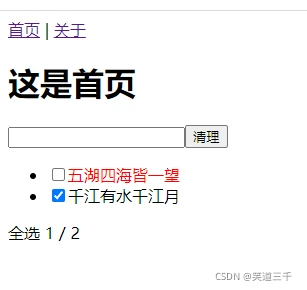注:本文是大圣老师课程的笔记,原课程地址:06 | 新的代码组织方式:Composition API + 到底好在哪里? (geekbang.org)
一,使用setup之后的改变
首先新建一个todoList.vue文件,然后写入如下代码:
<template> <div> <h1 @click="add">{
{
count}}</h1> </div> </template> <script setup> import {
ref } from "vue"; let count = ref(1) function add(){
count.value++ } </script> <style> h1 {
color: red; } </style> 在 script setup语法中,我们使用引入的 ref 函数包裹数字,返回的 count 变量就是响应式的数据,使用 add 函数实现数字的修改。需要注意的是,对于 ref 返回的响应式数据,我们需要修改 .value 才能生效,而在 script setup 标签内定义的变量和函数,都可以在模板中直接使用。
也就是说,从上面代码看,相较于vue2来说,有这点改变:
1,不再有export default,然后data,methods,components等的写法了,而是直接从vue引入相关api如(ref)来实现代码。 紧接着,把这个组件引入到home页面使用:
<template> <h1>这是首页</h1> <TodoList /> </template> <script setup> import TodoList from '../components/TodoList.vue' </script> 可以看到一个新的改变:
2,vue3的setup会自动注册组件,这样就减少了注册组件的一步。而可以直接使用。 完善代码后:
<template> <div> <div class="title"> <input type="text" @keypress.enter="add" v-model="title" /> <button v-if="active < all" @click="clear">清理</button> </div> <div class="content"> <ul v-if="todoList.length"> <li v-for="(item, index) in todoList" :key="index"> <input type="checkbox" v-model="item.done" /> <span :class="[item.done ? 'inactive' : 'active']"> {
{
item.content }} </span> </li> </ul> <div v-else>暂无数据</div> </div> 全选 {
{
active }} / {
{
all }} </div> </template> <script setup> import {
ref,computed} from "vue" //把这个useTodo解耦出来 function useTodos() {
let title=ref("") let todoList=ref([ {
content:"五湖四海皆一望", done:false },{
content:"千江有水千江月", done:true} ]) function add() {
const obj = {
content: title.value, done: false }; todoList.value.push(obj); title.value = ""; } function clear() {
todoList.value = todoList.value.filter((v) => !v.done) } let active=computed(()=>{
return todoList.value.filter((v) => !v.done).length }) let all = computed(() => todoList.value.length); let allDone = computed( {
get: function () {
return active.value === 0; }, set: function (value) {
todoList.value.forEach((todo) => {
todo.done = value; }); }, } ); return {
title,todoList,add,clear,active,all,allDone} } //其实你可以把组件内部的任何一段代码,从组件文件里抽离出一个独立的文件进行维护。 //再在这个组件中使用,于是这些东西就不依赖于this上下文了,这里再解构赋值出来 let {
title, todoList, add, clear, active, all, allDone } = useTodos(); import {
useMouse} from '../utils/mouse' let {
x,y} = useMouse() </script> <style scoped> </style> 这里又可以看到两个新的改变:
3,computed不再在return default里面,而是通过vue导入来使用,具体的计算属性作为参数传入。 4,和这个表单相关的功能,我们用useTodos函数包裹起来,又因为是ref实现的,和本组件解耦了,于是可以在想要的地方维护。不一定要放在本组件中,只要需要时引入使用即可。 二,解耦功能js代码的示例:
例如一个获取鼠标实时位置的功能,可以在util中新建这个文件:
import {
ref, onMounted,onUnmounted} from 'vue' export function useMouse(){
const x = ref(0) const y = ref(0) function update(e) {
x.value = e.pageX y.value = e.pageY console.log("测试鼠标",x.value,y.value) } onMounted(() => {
window.addEventListener('mousemove', update) }) onUnmounted(() => {
window.removeEventListener('mousemove', update) }) return {
x, y } } 然后只要在想要的地方引入使用就可以了:
import {
useMouse} from '../utils/mouse' let {
x,y} = useMouse() 三,css样式中也可以使用属性绑定js中的变量
<template> <div class="todoBox"> <div class="title"> <input type="text" @keypress.enter="add" v-model="title" /> <button v-if="active < all" @click="clear">清理</button> </div> <div class="content"> <ul v-if="todoList.length"> <li v-for="(item, index) in todoList" :key="index"> <input type="checkbox" v-model="item.done" /> <span :class="[item.done ? 'inactive' : 'active']"> {
{
item.content }} </span> </li> </ul> <div v-else>暂无数据</div> </div> 全选 {
{
active }} / {
{
all }} </div> </template> <script setup> import {
ref,computed} from "vue" //把这个useTodo解耦出来 function useTodos() {
let title=ref("") let todoList=ref([ {
content:"五湖四海皆一望", done:false },{
content:"千江有水千江月", done:true} ]) function add() {
const obj = {
content: title.value, done: false }; todoList.value.push(obj); title.value = ""; } function clear() {
todoList.value = todoList.value.filter((v) => !v.done) } let active=computed(()=>{
return todoList.value.filter((v) => !v.done).length }) let all = computed(() => todoList.value.length); let allDone = computed( {
get: function () {
return active.value === 0; }, set: function (value) {
todoList.value.forEach((todo) => {
todo.done = value; }); }, } ); return {
title,todoList,add,clear,active,all,allDone} } //其实你可以把组件内部的任何一段代码,从组件文件里抽离出一个独立的文件进行维护。 //再在这个组件中使用,于是这些东西就不依赖于this上下文了,这里再解构赋值出来 let {
title, todoList, add, clear, active, all, allDone } = useTodos(); import {
useMouse} from '../utils/mouse' let {
x,y} = useMouse() //定义这个color变量 let color=ref("red") </script> <style scoped> .active{
color:v-bind(color) } </style> 需要注意的是,color不能写在函数useToDo里面,因为函数外部读取不到,如果写里面,则还需要return,然后解构赋值才能使用。
实现的效果:

版权声明:
本文来自互联网用户投稿,该文观点仅代表作者本人,不代表本站立场。本站仅提供信息存储空间服务,不拥有所有权,不承担相关法律责任。
如若内容造成侵权、违法违规、事实不符,请将相关资料发送至xkadmin@xkablog.com进行投诉反馈,一经查实,立即处理!
转载请注明出处,原文链接:https://www.xkablog.com/qdvuejs/11060.html
